
The Valley of Flowers National Park

- Brief History of Valley of Flowers National Park :
The credit for the discovery of the Valley of Flowers generally goes to the British mountaineers Frank S. Smyth and R.L. Holdsworth who incidentally reached this valley after a successful expedition of Mount Kamet in 1931. Fascinated by its beauty and grandeur. Frank S. Smythe revisited this area in
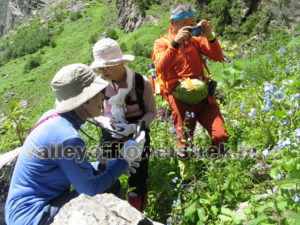
1937 and published a book named “The Valley of Flowers” (1938). But according to Sharma (1985) it was Colonel Edmund Smythe, an explorer and Education Officer in the Indian Army had visited this valley much earlier i.e. in 1862. However, there is no doubt that Frank S. Smythe’s writing made this valley world famous. A small para from the book Valley of Flowers is quoted below –
“I hope generously, my ignorance must judge for myself whether the Bhyundar Valley deserves its title the Valley of Flowers. Others will visit it, analyse it and probe it but, whatever their opinions, to me it will remain the ‘Valley of Flowers’ a valley of peace and perfect beauty where the human spirit may find repose”. For a small beautiful Primula Smythe writes “In all my mountain wanderings I had not seen a more beautiful flower than this “.
In 1939 Joan Margrett Legge from the Royal Botanic Gardens Kew. England visited the Valley of Flowers for plant collection. Unfortunately while collecting plants she fell off a cliff and died. The scripture at her tomb ‘I will lift up mine eyes unto the Himalaya from whence cometh my help’ reminds us of her faith in the Himalayas. Prior to 1982, the entire Bhyundar Valley used to be a summer grazing ground for migratory pastoralists. According to the local people every year two or three flocks (tolls) of sheep and goats would camp in the valley from early June to late September. Each flock contained about
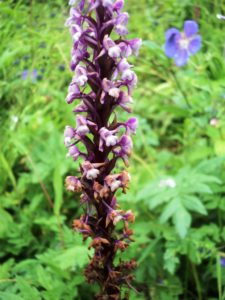
700-1000 sheep, goats and a few horses. Besides, buffaloes and cows of Bhyundar village numbering about 40-50 would also be left in the valley. The shepherds used two routes viz., one from the present entrance to the valley via pairra Pulna and another from Hanuman Chatti (from Badrinath side) to upland valley of Kunt Khal from where they would descend to upper slopes and further down to the centre of the valley. The major camping sites were Bamni Dhaur, Kunt Khal, Bistoli, Lower Drunager, Tipra and Syuchand. The shepherds used to station at each these places where their livestock would halt at night and let loose their herbs to roam freely on the slopes or flat lands during the day hours. Following the widespread publicity of the Valley of Flowers after 1938 and concern raised by several naturalists and conservationists about the degradation of alpine vegetation due to heavy livestock grazing and possible loss of floral diversity, 87.5 km2 area of the Valley of Flowers was declared as National Park by the Uttar Pradesh Government in 1982 vide G.O. No. 4278/XIV-3-66-80 dt. 06.09.82. After notification of the park the villagers have since shifted their grazing activities to the lower and side valleys away from the National Park viz., Kanjila, Roopdhunga, Serartoli and Rajkharak. In the year 2000 the Valley of Flowers National Park came under the domain of Nanda Devi Biosphere Reserve and became the second core zone of the Biosphere. The surrounding area of the park (the southern side) has thick forests of Fir, Taxus, Birch and Maple. The surrounding areas also have some beautiful Himalayan grassland and another valley which bears many exquisite Himalayan flowers like Himalayan lotus.
- Conservation Significance:
(A) Biological Significance

The valley of Flowers is a treasure land of exquisite floral and faunal, bio-diversity with myriads of alluring flowers. It is a benevolent gift of nature housing not only the store of floral diversity and natural beauty, but also the store of faunal diversity, which includes Himalayan tahr, Himalayan musk deer, Himalayan black bear, And Red fox etc. It encompasses about 300 species of wild flowers blooming in natural way. Primula is one of the most beautiful flowers besides Brahmakamal and many others. In the regional level it has major significance as sub-catchments of river Ganga. At the local level Valley of Flowers has a great potential as a tourism area which would help alleviate the economic conditions of the local population of the area. Of the 87.50 km2 park area nearly 63.58 km2 is estimated, to be under perpetual snow and glaciers based on satellite imagery. Forest areas in the National Park constitute only about 5.29 km2 area while the alpine meadows cover 18.63 km2. Based on the altitude, aspect and climatic conditions the vegetation of the park is divisible into three broad climatic zones viz; sub-alpine, lower alpine and higher alpine zone.
For a period of just 3 months nature splashes the valley with very beautiful colors. While green is the predominant shade the July mood of the valley is different from June and with the advent of September the entire colors starts fading away. The autumn bids farewell to the flowers which go to seed, lying in the expectation rainy spring. The exuberant carnival of color comes to a close, the multi-hued tapestry gives expression of brown and russet and gold of the dying leaves and the withering grass gives the whole landscape a soft hue before becoming snowbound.
The density of wild animals In the Valley of Flowers is not very large. A total of 13 wild mammal species have been recorded within the park and its vicinity. Of these only 9 species have been sighted directly viz., Himalayan musk deer (Moschus chrysogater), Mouse hare (Octhotona roylei), Himalayan black bear (Selenarctos thibetanus), Red fox (Vuples vulpes), Himalayan weasel (Mustela sibirica), Common langur (Presbytes entellus), Flying squirrel (Petaurista petaurista) and Himalayan yellow-throated marten (Martes flavigula). According to local people Himalayan brown bear (Ursus arctos), Bharal (Pseudois nayaur. Serow (Nemorhaedus sumatrensis), and Snow leopard (Panthera Uncia) are also also found in the park but not generally seen. In the year August 2002 there has been two confirmed sightings of Brown Bear in the adjacent area of the park (near Kakbhusandi Lake). Blue sheep droppings have also been found close to a high pass near Bhyundar Khal. Common leopard (Panthera pardus) is quite common and frequently sighted and droppings are found in and around the National Park.
(B) Religious Significance
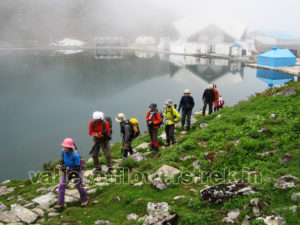
Near the Valley of Flowers is the sacred place of Sikhs the Hemkund Sahib, is situated at an attitude of 4150 mt. which is sacred to both Sikhs and Hindus. The Sikhs revere this place because their Tenth Guru described its location in his holy writings, in the Dasam Sahib (the books of the Tenth Guru). This location perfectly matches with the description where he meditated. Some historians hold that the Tenth Guru, Guru Gobind Singh, actually visited this place and was able to describe it because he had retreated there. They contend that Guru Gobind Singh sought reguge from the Raja of Garhwal at Srinagar but was refused because the Raja feared the Mughals and wished peace to reign in his kingdom. The best he could offer the fleeing Guru was the anonymity in the Himalayas. The Guru accepted this offer and retreated to this higher region and settled for a time near the shores of the lake surrounded by seven snow peaks.
For the Hindu the lake is known as Lokpal. Here, Lakshman the younger brother of Lord Rama, had meditated. A small temple is dedicated to Lakshman and it stands next to the Gurudwara. The lake was discovered in 1930 by Havildar Sohan Singh and since then it has become a major tourist attraction. The Sikh pilgrims have been the biggest draw for tourism in this area. Every year 3 to 5 lakh pilgrims visit Hemkund and Laxman mandir.
(C) Social and Economic significance
There is one major settlement called Bhyundar village near the park with it’s winter settlement little below called Pulna. However the population of these villages is not dependant on Valley of Flowers for any of their requirements. They on the other hand are very much dependant on tourism in the area. Even though the religious is the major draw in the area yet the number of tourists who visit the valley is also not less important because the valley only attracts foreign tourists. Stress is therefore being laid on making the Valley of Flowers more attractive to tourists, keeping in view that the influx of tourists should not harm the park. Tourism plays a very important role in the economic development of the area as about 95% populations of the surrounding villages depend on it. The main influx of tourists consists of Sikhs. Every year about 3 to 5 lakh pilgrims visit the area but only few thousands visit the valley.
- Area Description, Climate & Geography :
Boundary Description of Valley National Park made vide
Uttar Pradesh Govt. Order No. 4278/ 14-3 / 66 / 80 dated – 6 th Sept 1982
The boundary description of the Valley of Flower National Park is as under![]()
Northern Boundary- Northern boundary starts from Narparbat and goes upto Khuliaghata peak (16500 feet) and from this point goes up to Neelgiri (21240 feet) and then passes through Bhundyar Khal (16700 feet), terminates at Rataban (20220 feet).
Eastern Boundary- Beginning from Rataban Peak, running along the mountain ridges situated at the western side of Koshakunar Glacier, terminates at the peak of Goriparbat.
Southern Boundary- Starting from Goriparbat and running along the mountain ridges which divides the watershed of Pushpawati river, goes up to Chota (18700 feet) and then touches the river Pushpawati which is situated in the northern side of Hemkund & Ghangaria and then it turns towards northern direction along the river and after touching the northern point of Bhundyar Van panchayat, goes up to the peak of Kunthkhal Peak running along the ridges.
Western Boundary- It starts from Kuntkhal and runs along the parallel direction of Narparbat.
The Valley of Flowers National Park is a flat valley 5 km. long and 2 km. wide. The Valley has an admixture of forest and alpine grass lands with high snow covered peaks around. Its altitudinal range varies from 3200 to 6675 m. The park is surrounded by Gauri Parbat (6590m) and Rataban (6126 m) in the east, Kuntkhal (4430 m) in the west), in the west, saptsring (503 Pm) in the south and Nilgiri Par vat (6479 m) in the north. The Valley of Flowers National Park lies between at 30°411-30°481 N and longitude 79°331-79°461 E. The park is nestled among the snow summits viz Nilgiri Parvat (6407mt), Gauri Parvat (6590 mt) Rataban (5400 mt), Sapta Srinya (5025 mt) and Kunt Khal (5855 mt) and is surrounded by Ghangaria of Bhyundar valley in the south.
Climate
The Valley of Flowers National Park has a distinctive micro climate. There is heavy rain fall during the monsoon from June to August. Prevailing mist and low cloud during the monsoon keeps the soil moist. The Valley is usually snow bound for six month 18th October & March.
Important peaks and other geographical features
Geology of the area falls in Zansker range (Wadia/1966). The rocks are primarily sedimentary with mica schist and shale. The soil is acidic in nature (PH 3.8-6.1). The Valley of Flowers National Park is second Core of the Nanda Devi Biosphere Reserve. Some of the important localities within the Park are as follows- Paira (3200 mt), Lower nagtal (3300 mt), Bamni dhaur (3450 mt), Semar (3500 mt), Kundaliyasain (3500 mt.), Dronagar (3500-3600 mt), Sewachand (3600 mt), Tipra kharak (3700 mt) etc.
The area lying in the close proximity of the National Park include
Hemkund (4150 mt), Ghagria (3275 mt), Bhyundar village (2240 mt), Roopdhunga (2800 mt), Kanjila (3000 mt) etc.
- Maps :
- Flora, Fauna & flagship species :
The vegetation, forest types and main plant species found in the park
![]() The Valley of Flowers National Park is a treasure land of exquisite floral and faunal biodiversity with myriads of alluring flowers. The Flora of Valley of Flowers National Park encompasses over 520 species of flowering plants and more than 300 non vascular plants typical of Western Himalaya of which about 300 species bear beautiful flowers that bloom in natural way in this valley from May to October. Primula is one of the most beautiful flowering species besides Brahmakamal (Saussurea obvallata) and many others. Its flowering mid July to mid August many species are- Anemone rivularis, Geranium wallichianum, Marse marigold, Primula denticulata, Potentilla atrosanguinea, Aster albescens, Himalayan blue popy, Aconitum violaceum, Lillium nanum, Inula obtusifolia, Saussurea obvallata, Campanula latifolia, Pedicularis bicornuta, Arisaema jacquemontii, Morina longifolia, Impatiens sulcata, Bistorta macrophylla, Ligularia amplexicaulis, Anaphalis busua, Saxifragfa parnassifolia, Thermopsis barbata, Corydalis cashmeriana, Aquilegia pubiflora, Codonopsis viridis, Dactylorhiza hatagiree, Cypripedium himalaicum, Rhododendron campanulatum, Polemonium caerulium etc.
The Valley of Flowers National Park is a treasure land of exquisite floral and faunal biodiversity with myriads of alluring flowers. The Flora of Valley of Flowers National Park encompasses over 520 species of flowering plants and more than 300 non vascular plants typical of Western Himalaya of which about 300 species bear beautiful flowers that bloom in natural way in this valley from May to October. Primula is one of the most beautiful flowering species besides Brahmakamal (Saussurea obvallata) and many others. Its flowering mid July to mid August many species are- Anemone rivularis, Geranium wallichianum, Marse marigold, Primula denticulata, Potentilla atrosanguinea, Aster albescens, Himalayan blue popy, Aconitum violaceum, Lillium nanum, Inula obtusifolia, Saussurea obvallata, Campanula latifolia, Pedicularis bicornuta, Arisaema jacquemontii, Morina longifolia, Impatiens sulcata, Bistorta macrophylla, Ligularia amplexicaulis, Anaphalis busua, Saxifragfa parnassifolia, Thermopsis barbata, Corydalis cashmeriana, Aquilegia pubiflora, Codonopsis viridis, Dactylorhiza hatagiree, Cypripedium himalaicum, Rhododendron campanulatum, Polemonium caerulium etc.
The Valley of Flowers National Park is a benevolent gift of nature housing not only the floral diversity![]()
![]() and natural beauty, but also the faunal diversity. The distribution of wild animals in Valley of Flowers National Park is exciting although their density is not so much. A total of 13 species of wild mammals have been recorded within the Park and its vicinity of these only 9 species have been sighted directly viz. Himalayan thar (Hemitragus jemlahicus), Himalayan black bear (Selenarctos thibetanus), Red fox (Vulpes vulpes), Himalayan weasel (Mustela sibirica), Common langur (Presbytes entellus), Flying squirrel (Petaurista petaurista) and Himalayan yellow marten (Martes flavigula). Several direct and indirect evidences have have confirmed the presence of Himalayan brown bear (Ursus aretos) Bharal or Blue sheep (Pseudois nayaur), Serow (Capricornis sumatrenses), and snow leopard (Panthera uncia) within the Park. Monal (Lophophorus impejanus) is frequently seen among birch-rhododendron scrub. Common leopard (Panthera pardus) is reported from lower parts of the valley, closer to the human habitation. The bird species frequently seen in the valley include Koklass Pheasant, Monal Pheasant, Kalij Pheasant, Scaly-Bellied Woodpecker, Greater yellow naped woodpecker, Great Barbet, Blue throated Brabet, Eurasian Eagle Owl, Rock Pigeon, Hill Pigeon, Wood pigeon , Snow Pigeon, Spotted Dove, Lammergeir, Himalayan Griffon, Yellow Billed Chough, Red Billied Chough, and Red billed Blue Magpie.
and natural beauty, but also the faunal diversity. The distribution of wild animals in Valley of Flowers National Park is exciting although their density is not so much. A total of 13 species of wild mammals have been recorded within the Park and its vicinity of these only 9 species have been sighted directly viz. Himalayan thar (Hemitragus jemlahicus), Himalayan black bear (Selenarctos thibetanus), Red fox (Vulpes vulpes), Himalayan weasel (Mustela sibirica), Common langur (Presbytes entellus), Flying squirrel (Petaurista petaurista) and Himalayan yellow marten (Martes flavigula). Several direct and indirect evidences have have confirmed the presence of Himalayan brown bear (Ursus aretos) Bharal or Blue sheep (Pseudois nayaur), Serow (Capricornis sumatrenses), and snow leopard (Panthera uncia) within the Park. Monal (Lophophorus impejanus) is frequently seen among birch-rhododendron scrub. Common leopard (Panthera pardus) is reported from lower parts of the valley, closer to the human habitation. The bird species frequently seen in the valley include Koklass Pheasant, Monal Pheasant, Kalij Pheasant, Scaly-Bellied Woodpecker, Greater yellow naped woodpecker, Great Barbet, Blue throated Brabet, Eurasian Eagle Owl, Rock Pigeon, Hill Pigeon, Wood pigeon , Snow Pigeon, Spotted Dove, Lammergeir, Himalayan Griffon, Yellow Billed Chough, Red Billied Chough, and Red billed Blue Magpie.
- People of the landscape :
There is no village inside the national park. However, 3 villages- Pulna, Bhyundar & Ghangaria outside![]() the boundary of the park. Pulna is permanent village while other to are seasonally occupied in summer season. Ghangaria is the centre of activities for tourists during summer season. Nearly five lacks Sikh pilgrims visit to Hemkund Sahib during the season. The residence of Pulna village are Indo-Aryans in origin dominated by Rajputs of Chauhan creed this village does not have any tribal community.
the boundary of the park. Pulna is permanent village while other to are seasonally occupied in summer season. Ghangaria is the centre of activities for tourists during summer season. Nearly five lacks Sikh pilgrims visit to Hemkund Sahib during the season. The residence of Pulna village are Indo-Aryans in origin dominated by Rajputs of Chauhan creed this village does not have any tribal community.
- Visitor Information :
- Seasonality : The Valley of Flowers National Park can be visited from 1st June to 30th September. However the best time for flower viewing is the July and August months. During rainy season the whole park gives a green look with sparkling meadows dotted with wild flowers.
- How to reach
The valley can be easily approached from the Rishikesh-Deoprayag-Srinagar-Rudraprayag- Karanprayag-Chamoli-Pipal Koti-Joshimath-Vishnu Prayag-Govindghat-Badrinath route. On this road
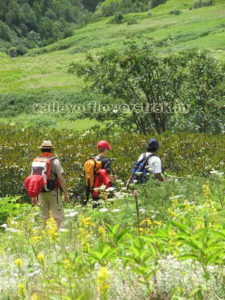
at about 25 Km distance from Joshimath is Govindghat. From Govindghat one has to trek 13 Km to reach Ghangaria. From Ghangaria the valley is situated at a distance of 3 km. From Dehradun or Haridwar one can reach upto Joshimath (320 km.) or Govinghat (another 25 km.) and stay for the night at these palaces and can start his trek next day to Ghangaria. However the valley can best be seen only next day morning hours.
- Zonation
Valley of Flowers National Park and areas surrounding to it can be classified as under –
- a) Core zone
Core zone consisting of area of the National Park. In which only tourism activity and eco- restoration activities are only allowed.
- b) Buffer zone
Buffer zone consisting of area surrounding to the National Park. In buffer area tourism eco development, eco-restoration and research activities are carried out.
- Entry gates
The municipal gate timings from Joshimath to Govindghat area start from 6 AM every day. No one is allowed after 6 PM. The gate timings for entering into the Valley of Flowers National Park is from morning hours to noon (upto 3 PM).
- Distances
Dehardun to Joshimath – 320 Km.
Joshimath to Govindghat – 25 Km.
Govindghat to Ghangaria – 13 Km. (on foot)
- Facilities and Accommodation
Forest Rest house with two suites is available at Joshimath, Govindghat and Ghangaria. Electricity, Water and Kitchen facilities are available at these rest houses. Apart from Forest Rest House, Garhwal Mandal Vikas Nigam’s Tourist Rest House and many private hotels and Lodges are available at Joshimath, Govindghat and Ghangaria. Ordinary food is also available in the Hotels and Lodges.
- Activities
Nature trails & trekking-
- a) Bamnidhar-Legges grave – 0 km.
- b) Legges grave-Syunchand – 5 km.
- c) Syunchand-Tipra kharak – 0 km.
- d) Bamnidhar-Kuntkhal- Hanumanchatti – 0 km.
- Rates and Tariffs-
| S.N. | Description | Indian (Rs.) | Foreigner (Rs.) |
| 1 | a) Entrance Fee (In Rs.) Per head for first three days. | 40.00 | 350.00 |
| b) For additional three days | 25.00 | 150.00 | |
| 2 | Camera fees | ||
| a) Still camera (non professional) | Free | Free | |
| b) Still camera (professional) | 100.00 | 100.00 | |
| c) Movie/ Video (non professional) | Free | Free | |
| d) Movie/ Video (professional) | 100.00 | 100.00 | |
| 3 | Filming Charges | ||
| a) Feature film per day | 20000.00 | 20000.00 | |
| b) Documentary film per day | 2500.00 | 5000.00 | |
| 4 | Security for above | ||
| a) Feature film per day | 50000.00 | 100000.00 | |
| b) Documentary film per day | 25000.00 | 50000.00 |
Reservation and permits
No advance permit is required. A visitor can pay the entrance fee at gate and can enter in the park area. A copy of rules and regulations is given to the visitor before he starts his trek in side the park area.
- Rules
- Don’t camp or stay for the night inside the park.
- Don’t destroy, trample, collect or remove any plant and animal specimen whether live or dead or any geological specimen.
- Don’t carry and introduce any alien seeds or propagation material or any plant species and don’t carry and introduce any exotic animals or pets.
- Don’t kindle fire; throw lighted matches and Cigarette/Bidi butts.
- Don’t go for mountaineering, climbing, swimming or any type of adventure activity.
- Don’t carry instruments, implements, tools, arms, firearms or chemicals harmful to wildlife and vegetation.
- Don’t shout, hoot, play audio and video tapes/radio inside the park.
- Don’t try to feed any wild animal.
- Don’t damage, break or distort the facilities provided by the park authorities.
- Don’t deface, put sign boards, write or paint on the tree trunks/rocks or on any infrastructure (boundary walls and boundary pillars).
- Nearby places of interest
Kagbhusandi Lake
It is a small oblong lake of emerald green water at an altitude of about 5000 mt near Kankul Pass (5230 mt); almost a kilometer in length. Myriad blossoms decorate its banks during the season with some of the wildest profusion of colours and make one forget the hardships and the exhaustion of the trek. Set in the lap of Hathi Parvat (6730 mt) the lake can be approached either from Bhyundar village, near Ghangaria or from Vishnu Prayag. The trek from the former is a little easier in gradient than the latter one, but longer. The trek from Bhyundar passes through thick bear infested forests, and stretches of stinging nettles without any shelters, except shepherd huts. It also involves walking on glacial moraines and slippery rocks over long distances. Local guides are available at Bhyundar village.
- Contacts
- a) Principles Chief Conservator of Forest/Chief Wildlife Warden,
Wildlife, Uttaranchal, 5 Chandrabani,
Po- Mohabewala, Dehradun
Pin- 248001
Phone- (0135) 2644691
- b) Director/Conservator of Forest
Nanda Devi Biosphere Reserve, Gopeshwar
District- Chamoli.
Phone- (01372) 252497
- c) Deputy Conservator of Forest
Nanda Devi National Park, Joshimath
District- Chamoli, Uttaranchal
Pin- 246443
Phone- (01389) 222179
- Threats & Problems :
The domination of Polygonum polystachyum has been observed dominating on disturb areas such as eroded scree slops bouldery areas and avalanche prone areas. It has been observed that flowering of different species is profuse and timely in those areas where the Polygonum was absent. There fore removal of Polygonum before flowering is necessary for controlling spread of Polygonum.
- Management Programme :
Thrust areas of management are as under-
- a) Habitat improvement works
Habitat improvement consists of bringing into useful association of those conditions needed by a species to reproduce and survive. Even creation of small openings is even of great value and importance. Such openings are essential for herbaceous cover and insect production on which ground living animals like pheasants predominantly feed during the first few weeks of life. Some of the works which will be conducted under this prescription are as under-
- Polygonum removal
One flowering species named Polygonum polystchym, which is even though a good soil binder and colonizer, it has taken a proportion of a weed in the park and it has been observed that it has been retarding the growth of some of the flowers in the park. The Wildlife Institute of India has however suggested doing some experimental studies on the effect of cutting of Polygonum. As such in about 30 ha. Area 10 check plots have been created and polygonum has been removed in a phased manner. This research and data recording has been continuing. From the very start melting of snow in the high altitude grass lands, Polygonum will be continually removed from all other areas physically specially from the zones where other flowers bloom and has a record of blooming. Polygonum will however not be removed from the slopes and fresh soil erosion areas as result of glacier actions.
- b) Protection works
- Patrolling
In order to maintain the dynamic state of the ecosystem and to ensure that the evolutionary processes are not hampered, the natural systems should be least disturbed. The aim of protection activity is to preserve the genetic and species diversity of both the parks. More so the forest staff posted in the region are also legally duty bound to maintain strict vigil against any unlawful activity. Regular patrolling and maintenance of vigil are the core elements of protection works As such Long range and short range patrolling will be a regular feature of the management. Every month 2 short range and one long range patrolling will be carried out inside and peripheral region of the parks. A roster of these patrolling will be made in advance. In this patrolling activity local youths/EDC members/Ex-servicemen will also be associated and they will be given remuneration on daily work basis.
- Maintenance of secret fund
A secret method of intelligence will be developed involving all stakeholders and a secret fund will be kept to run this intelligence network. This is essential to provide incentives to the informers and to those who provide vital to the forest personnel in the field during actual raid operations.
iii. Fire protection and control
Fire is a good wildlife tool if used properly and judicially. But forest fires when break unwarranted do considerable harm. As such strict fire vigil has to maintain in the buffer and transition zones and warrant special vigil specially during the summer months in the lower zones and in the months of Oct- Nov and March to May in the higher zone.
- Immunization
In the high altitude grass lands near the villages situated in the close proximity of the both the park, the domestic cattle (specially sheep and goat) graze during summer months. Many wild herbivores that also come to these areas from the nearby core zone also graze on these areas. Spread of disease like foot and mouth disease from the domestic cattle to wild animals always loom large. As such regular immunization of the domestic animals is necessary.
- Strengthening of ant poaching camps and chaukies
The staff who live in far flung remote areas need basic facilities like a safe and comfortable space to live in. Heavy rain and other vagaries of nature badly affect their quarters which are mostly situated in the higher reaches. As such these quarters call for annual maintenance. This activity is most important from the point of view of protection and regular patrolling activity.
- Legal support
Quick deterrent action in case of forest offence is very essential for keeping control over poachers and law breakers. However action in court requires funds. As such provisions have been made under this head.
vii. Arms and Ammunition and tranquilizing cartridges
All the field staff of both the parks has been provided with fire arms for self defense and for meeting any exigencies. As such provisions have been made under this head to buy ammunition and tranquilizing cartridges.
- c) Awareness & Training
Liaison with the community is essential as the health or condition of the environment is reflected by the manner in which we treat or manage it. Increasing awareness of what biodiversity is pressures that impact upon it, its intimate and essential connection to human survival and ways in which everyone can play a role in conservation is a necessary component for future conservation of biodiversity. These awareness programmes therefore will be taken up for the following purposes.
- To identify, establish and develop a process by which the staff of the department can understand the new paradigm of forestry and can be motivated to increase his own skill and knowledge.
- To increasingly involve people in and around P.A s into conservation planning and management of the area.
- To raise the level of awareness among the local community for the value and conservation needs of the protected area and patterns of economic growth and development which are locally appropriate and environmentally sustainable.
- To build the capacity of the community (specially of the women and youth) for self employment using the local natural resource (of the buffer area) and methods which do not jeopardize ecological sustainability.
- To actively involve the students and teachers in the nature conservation programmes and for dissemination of knowledge and awareness about conservation of flora and fauna of the Reserve.
- d) Research and Monitoring
World Heritage listing of Valley of Flowers National Park and application for inscription of Nanda Devi Biosphere Reserve as whole in the world list of Bio sphere Reserve brings with it the obligation to monitor and research the condition of a listed property. The results of research and surveys in the Reserve provide baseline information about natural and cultural resources and visitors’ use of the Reserve against which the state of the environment can be gauged in regular monitoring programs. Flora and fauna and habitats need to be monitored over the long term for a complete understanding of the factors influencing the abundance and distribution of fauna. Flora and fauna monitoring in the Reserve provides useful information for regional conservation programs, local people’s enterprises, and the eco- tourism.
- Census
Regular animal abundance survey is an essential part of the management and as such this activity will be taken up in the parks.
- e) Communication and networking
The following steps will be taken to strengthen the communication and networking in the Reserve.
- Surface communication development
For enforcing surface communication the first requirement is mobility of the field staff and as such 4 motor cycles for the staff (two each for both the National Parks) and one diesel jeeps with large body for Range Officer of Nanda Devi National Park and one Patrol Geep for the Dypt. Director of the Nanda Devi National Park Forest Division are essential.
- Wireless communication development
In the rugged terrain of NDBR, wireless communication is a very effective and fast means of communication. The basic equipments for setting up of base stations and hand sets have already been bought.
- f) Conflict management
The basic aim of this activity is to keep the man animal conflict in control. Cattle lifting or loss of human life due to wild animal man conflict pose a serious threat to the life of the malignant animal. People will be educated about the traditional and institutional mechanism of reduction of conflict. Documentation of such practices will also be done. However despite all preventive measures, cattle lifting cases do take place and as such payment of ex-gratia payment will be made to the victims to reduce conflict as quickly as possible.
- g) Trek route maintenance and development
Creation of National Park have also affected the livelihood opportunities of the locals which used to come way of serving as guides and porters in mountaineering and trekking activity inside the park. Therefore the avenues for alternate livelihood support had to be explored. Development of trek routes and Nature trails facilitate patrolling of the forest department on one hand and on the other hand it enables the local populace to enhance nature based tourism in the area which is coming up as an important source of livelihood support activity in the buffer and transition zone areas.
- Funding pattern :
Funds provided for the management of national park under centrally sponsored scheme Development of national park & sanctuaries annually-
- Organisational structure :
Addl. PCCF, Wildlife, Uttaranchal
CF/Director, Nanda Devi Biosphere Reserve, Gopeshwar
DFO, Nanda Devi National Park, Joshimath
SDO, Nanda Devi National Park, Joshimath
RO, Valley of Flowers National Park, Govindghat
AWLW, Valley of Flowers National Park, Govindghat
WLG, Valley of Flowers National Park, Govindghat
- Innovative approaches :
The Govindghat-Ghangaria route which is 13th km. long has variety of land status due to multiplicity of
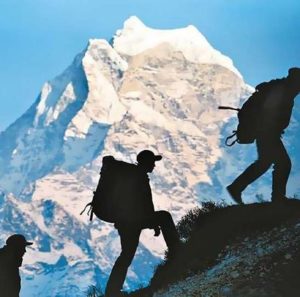
control the whole trek used to experience mushrooming of temporary shops had been counted in the year 2002. Since these shopkeeper used to congregate in the area all over the places including some from outside state with the sole intention of making fast bucks in a small period of 4 to 5 month, they had little are no concern for the amount of garbage they were living behind. A big piles of bottles, wrappers, plastics & paper plates and score other biodegradable things had been piling of behind is shop everywhere. No efforts had ever been made to remove this garbage from these sites. More over around 5 lakh Sikh pilgrims visit Hemkund Sahib also leave plastic bottles, rain coats, toffy/buiscuts /choklets wrappers recklessly every year. The Ghangaria area also has about 16th hotels, shops & a big Gurudwara which where again a principle causing factor for compilation of big amount of garbage. In the year 2003 villagers of Bhyundar constituted Eco Development Committee, Bhyundar to remove the garbage and make the trek & valley clean. In the tourism season year 2003 and 2004 the EDC, Bhyundar and Govindghat have removed all the past garbage from the buffer area of the park and have been successful in implementing self sustainable management of the garbage in the whole buffer area of the park.
- Perception of the future :
Edo Development
Under this cultivation of medicinal plants will be undertaken the areas surrounding National Park called as buffer zone, abounds in medicinal plants of a great variety which have been traditionally used and exported by the villagers.
Development of Interpretation Centre
Interpretation is the communication link between the visitor and the resources, be it geological, processes, plants, animals ecological communication, history or pre-history of man. It is needed to explain the place of man in his environment to increase visitor or public awareness of the importance of this relationship and to awaken a desire to contribute to environmental conservation. To objectives interpretation programmes are as follows-
- To help visitor in developing awareness, appreciation and understanding of the area.
- To make the visitors experience enjoyable.
- To create conservation awareness.
- To achieve management goals.
- Important references :
Landscape plan of Nanda Devi Biosphere Reserve and the Management Plan of Valley of Flowers.
********************************************************************************
Report By : Youth icon Yi National Creative Media Report (Shashi Bhushan Maithani ‘Paras’ )
with Santosh Kunwar. Adventure Trekking Pvt. , Joshimath 1.05.2016 ,
Thanks for valuable information…
Very nice and detailed information.